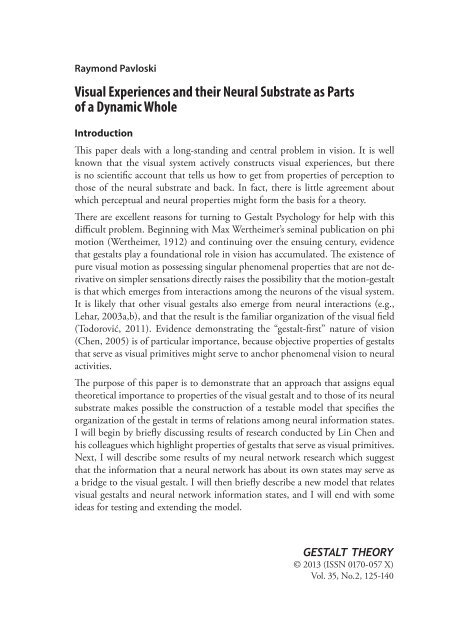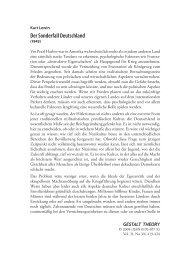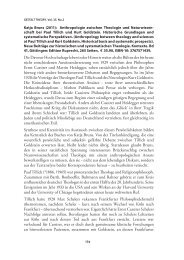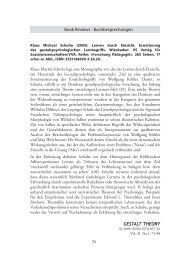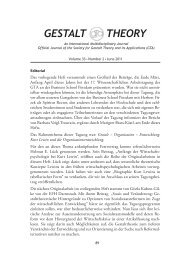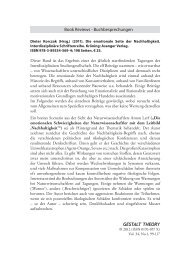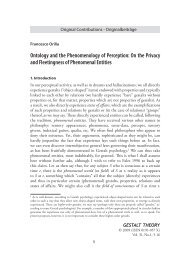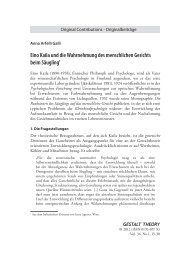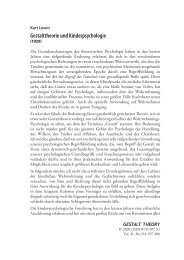Visual Experiences and their Neural Substrate as ... - Gestalt Theory
Visual Experiences and their Neural Substrate as ... - Gestalt Theory
Visual Experiences and their Neural Substrate as ... - Gestalt Theory
You also want an ePaper? Increase the reach of your titles
YUMPU automatically turns print PDFs into web optimized ePapers that Google loves.
Raymond Pavloski<br />
<strong>Visual</strong> <strong>Experiences</strong> <strong>and</strong> <strong>their</strong> <strong>Neural</strong> <strong>Substrate</strong> <strong>as</strong> Parts<br />
of a Dynamic Whole<br />
Introduction<br />
This paper deals with a long-st<strong>and</strong>ing <strong>and</strong> central problem in vision. It is well<br />
known that the visual system actively constructs visual experiences, but there<br />
is no scientific account that tells us how to get from properties of perception to<br />
those of the neural substrate <strong>and</strong> back. In fact, there is little agreement about<br />
which perceptual <strong>and</strong> neural properties might form the b<strong>as</strong>is for a theory.<br />
There are excellent re<strong>as</strong>ons for turning to <strong>Gestalt</strong> Psychology for help with this<br />
difficult problem. Beginning with Max Wertheimer’s seminal publication on phi<br />
motion (Wertheimer, 1912) <strong>and</strong> continuing over the ensuing century, evidence<br />
that gestalts play a foundational role in vision h<strong>as</strong> accumulated. The existence of<br />
pure visual motion <strong>as</strong> possessing singular phenomenal properties that are not derivative<br />
on simpler sensations directly raises the possibility that the motion-gestalt<br />
is that which emerges from interactions among the neurons of the visual system.<br />
It is likely that other visual gestalts also emerge from neural interactions (e.g.,<br />
Lehar, 2003a,b), <strong>and</strong> that the result is the familiar organization of the visual field<br />
(Todorović, 2011). Evidence demonstrating the “gestalt-first” nature of vision<br />
(Chen, 2005) is of particular importance, because objective properties of gestalts<br />
that serve <strong>as</strong> visual primitives might serve to anchor phenomenal vision to neural<br />
activities.<br />
The purpose of this paper is to demonstrate that an approach that <strong>as</strong>signs equal<br />
theoretical importance to properties of the visual gestalt <strong>and</strong> to those of its neural<br />
substrate makes possible the construction of a testable model that specifies the<br />
organization of the gestalt in terms of relations among neural information states.<br />
I will begin by briefly discussing results of research conducted by Lin Chen <strong>and</strong><br />
his colleagues which highlight properties of gestalts that serve <strong>as</strong> visual primitives.<br />
Next, I will describe some results of my neural network research which suggest<br />
that the information that a neural network h<strong>as</strong> about its own states may serve <strong>as</strong><br />
a bridge to the visual gestalt. I will then briefly describe a new model that relates<br />
visual gestalts <strong>and</strong> neural network information states, <strong>and</strong> I will end with some<br />
ide<strong>as</strong> for testing <strong>and</strong> extending the model.<br />
GESTALT THEORY<br />
© 2013 (ISSN 0170-057 X)<br />
Vol. 35, No.2, 125-140
GESTALT THEORY, Vol. 35, No.2<br />
<strong>Gestalt</strong>s that Serve <strong>as</strong> <strong>Visual</strong> Primitives<br />
Vision research is dominated by work that is b<strong>as</strong>ed on the <strong>as</strong>sumptions that visual<br />
processing proceeds from local to global, from computationally simple to<br />
complex, <strong>and</strong> from phenomenal part to whole (see discussion by Chen, 2005).<br />
Such <strong>as</strong>sumptions are routinely given more weight than other <strong>as</strong>sumptions that<br />
might follow from what is known about perceptual organization. However, the<br />
commonly-held <strong>as</strong>sumptions that vision is fundamentally a part-to-whole, computationally<br />
simple-to-complex, <strong>and</strong> local-to-global process are challenged by a<br />
series of studies carried out by Lin Chen <strong>and</strong> his colleagues.<br />
Aspects of visual gestalts that are invariant under certain types of transformations<br />
form the keystone of Chen’s work. According to Chen’s (2005) theory of topological<br />
structure <strong>and</strong> functional hierarchy, visual perception is fundamentally global<br />
in nature, <strong>and</strong> this is described by the primary role of topological invariants<br />
in vision. Topological transformations change the locations, shapes, <strong>and</strong> sizes of<br />
visual images, but do not change the connectivity, the number of holes, or the<br />
inside-outside relationship of an image (see Mendelson, 1990 for an exceptionally<br />
clear introduction to topology). Therefore, these latter three properties are<br />
invariant under topological transformations. The theory also holds that global topological<br />
perception is temporally prior to the perception of other featural properties<br />
that represent geometrically less stable, <strong>and</strong> therefore more local <strong>as</strong>pects of<br />
a visual image, such <strong>as</strong> its shape <strong>and</strong> size. Using a variety of methods, Chen <strong>and</strong><br />
his colleagues have demonstrated that gestalts that are invariant under topological<br />
transformations are more perceptually salient <strong>and</strong> are extracted more rapidly by<br />
the visual system than are other types of visual features (Chen, 1982, 1985, 1990;<br />
Chen & Zhou, 1997; Todd, Chen, & Norman, 1998; Zhou, Zhang, & Chen,<br />
2008). According to Chen (2005), such gestalts serve <strong>as</strong> visual primitives.<br />
Several types of evidence provide converging support for Chen’s theory. For example,<br />
illusory conjunctions of certain kinds of visual features occur when dem<strong>and</strong>s<br />
are placed on attention (e.g., Treisman <strong>and</strong> Gelade, 1980). If topological<br />
properties are visual primitives, then illusory conjunctions of properties such <strong>as</strong><br />
holes should occur. Using a very conservative estimation procedure, Chen <strong>and</strong><br />
Zhou (1997) found that illusory conjunctions of topological properties occurred<br />
on 17.6% of trials.<br />
There is a great deal of additional evidence for Chen’s contention that topological<br />
invariants serve <strong>as</strong> visual primitives. Both two- (Chen, 1982, 1990) <strong>and</strong> three-dimensional<br />
stimuli (Todd, Chen, & Norman, 1998) that differ in topological<br />
properties are more discriminable <strong>and</strong> are more rapidly identified than stimuli<br />
that differ only in non-topological properties. Furthermore, subjects experience<br />
apparent motion between stimuli that are topologically equivalent even when the<br />
objects differ in shape (Chen, 1985), <strong>and</strong> fMRI shows corresponding activity in<br />
the anterior temporal cortex (Zhou, Zhang, & Chen, 2008).<br />
126
Pavloski, <strong>Visual</strong> <strong>Experiences</strong> <strong>and</strong> <strong>their</strong> <strong>Neural</strong> <strong>Substrate</strong> <strong>as</strong> Parts of a Dynamic Whole<br />
This work is highly relevant to the t<strong>as</strong>k of bridging the visual gestalt <strong>and</strong> its neural<br />
underpinnings. Topologically-invariant structures may define what it means for<br />
something to be perceived <strong>as</strong> an object, <strong>and</strong> <strong>their</strong> objectively-defined properties<br />
can be used to anchor visual phenomena to the neural substrate. These structures<br />
are holistic, <strong>and</strong> they are properly termed gestalts. What properties of neural activity<br />
are related to such gestalts?<br />
Information in Richly-Interconnected <strong>Neural</strong> Networks<br />
Fig. 1. In the neural network simulations reported in this paper, network neurons (small filled circles<br />
at bottom) are grouped into clusters, <strong>and</strong> neurons in any given source cluster have equivalent effects<br />
on neurons in any given target cluster. There are synapses between all pairs of neurons in the network,<br />
shown <strong>as</strong> heavy black lines between neurons comprising each of four clusters, <strong>and</strong> <strong>as</strong> lighter gray lines<br />
between neurons in different clusters. Inputs to the network are not shown on this figure. One model<br />
neuron is shown in an exp<strong>and</strong>ed view on the top part of the figure, where the action potential outputs<br />
carried by the axon that form the typical focus of neural network simulations are contr<strong>as</strong>ted with inputs<br />
to dendrites. The focus of research using these simulations is on simulated ionic conductance values<br />
produced within network neurons by network neurons, because it is these conductance values that<br />
constitute the information that each network neuron h<strong>as</strong> about the state of its network.<br />
127
GESTALT THEORY, Vol. 35, No.2<br />
I have argued that it may be fruitful to think of vision in terms of how a network of<br />
neurons represents its own activity – to focus on inputs to neurons (Pavloski, 2006,<br />
2008, 2010, 2011; see Figure 1). The most common result of input to a neuron is<br />
a change in the conductivity of that neuron’s membrane for a specific type of ion.<br />
A conductance value at a synapse constitutes a reduction of uncertainty about<br />
the state of the network of which the neuron is a part, <strong>and</strong> therefore provides<br />
information that the neuron h<strong>as</strong> about the state of its network. At a larger scale<br />
(e.g., the scale of a small neural network), a pattern of conductance values might<br />
be organized into a form along dimensions that we recognize <strong>as</strong> describing a visual<br />
gestalt. Restated from a visual perspective, a gestalt might be a holistic <strong>and</strong><br />
complex information state that organizes a set of individual conductance values<br />
at the scale of a neural network.<br />
Motivated by this possibility, my research for the p<strong>as</strong>t 6-7 years h<strong>as</strong> focused on analyzing<br />
the results of computer simulations in order to determine how patterns of<br />
conductance values are organized by the activities of richly-interconnected neural<br />
networks (Pavloski, 2006, 2008, 2010, 2011). In these simulations, network<br />
neurons are grouped into clusters (of nine excitatory neurons <strong>and</strong> one inhibitory<br />
neuron) in order to promote stability. Each neuron receives inputs from all network<br />
clusters, including from its own cluster. All neurons in a source cluster have<br />
equivalent effects on all neurons in a given target cluster, up to r<strong>and</strong>om variation.<br />
128
Pavloski, <strong>Visual</strong> <strong>Experiences</strong> <strong>and</strong> <strong>their</strong> <strong>Neural</strong> <strong>Substrate</strong> <strong>as</strong> Parts of a Dynamic Whole<br />
Fig. 2. The clusters of simulated neurons were <strong>as</strong>signed fictional positions <strong>as</strong> shown by the black<br />
disks in this illustration, <strong>and</strong> the strength of each synapse from a source cluster to a target cluster<br />
varied inversely with the fictional distance between the pair. The results of computer simulations<br />
described in the text were obtained by applying inputs above resting b<strong>as</strong>eline levels (i.e., r<strong>and</strong>om<br />
firing) to four clusters on the first of the sheets of clusters, <strong>and</strong> to all clusters on the seventh sheet.<br />
In these simulations, the strengths of synapses are b<strong>as</strong>ed on a network-wide rule<br />
designed to promote the emergence of patterns of conductance values with a<br />
three-dimensional, visual space–like structure. In the example shown in Figure<br />
2, 343 clusters were <strong>as</strong>signed fictional positions on seven square sheets organized<br />
into a cubic shape, <strong>and</strong> synaptic weights from source to target decre<strong>as</strong>ed with the<br />
fictional distance from source to target. For each simulation, input w<strong>as</strong> provided<br />
in some pattern to the neurons that composed the 343 clusters of this network<br />
<strong>and</strong> the states of all neurons in the network were updated until a stable pattern<br />
of ionic conductance values w<strong>as</strong> achieved. In the example illustrated in Figure 2,<br />
excitatory inputs were applied for a total of 16 updates to neurons in four clusters<br />
on the first sheet <strong>and</strong> to neurons in all 49 clusters on the seventh sheet.<br />
129
GESTALT THEORY, Vol. 35, No.2<br />
Fig. 3. The information that a neural network h<strong>as</strong> about its own state is collected in a matrix of<br />
simulated ionic conductance values g ij , where the first index i represents the cluster that is the<br />
source of input to the target cluster j. The information that a network with m clusters h<strong>as</strong> about its<br />
own state is therefore represented by an m x m matrix G. For the example network described in the<br />
text, m=343. If the individual conductance values were not related, all 343 dimensions would be<br />
required to represent this information. However, singular value decomposition (SVD) of such matrices<br />
indicates that only 4 dimensions account for over 99% of the variance in conductance values.<br />
Three of these dimensions describe the fictional positions <strong>as</strong>signed to clusters, <strong>and</strong> the remaining<br />
dimension describes the information that each cluster receives about its own state (i.e., diagonal<br />
elements g ii ), which is referred to <strong>as</strong> contr<strong>as</strong>t in the text. Therefore, to change the value g ij to the<br />
value g km , the contr<strong>as</strong>t of cluster i must be transformed to the contr<strong>as</strong>t of cluster k, <strong>and</strong> the distance<br />
between clusters i <strong>and</strong> j must be transformed to the distance between clusters k <strong>and</strong> m.<br />
At any point in time, the information that the network h<strong>as</strong> about its own state<br />
can be collected in a matrix of conductance values, <strong>as</strong> depicted in Figure 3. For<br />
example, g 12 is the total conductance in cluster 2 neurons due to neurons in<br />
cluster 1. Singular value decomposition of the matrix (Deerwester et al., 1990;<br />
Kalman, 1996; L<strong>and</strong>auer et al., 1998) shows that the input conductance values<br />
in each cluster self-organize along only four dimensions – a three-dimensional<br />
position <strong>and</strong> a dimension showing the information that each cluster receives from<br />
its own neurons. The magnitudes of the 55 largest singular values (out of 343)<br />
are plotted at the top of Figure 4. To be consistent with calling the dimensions<br />
corresponding to three of these values position, the remaining dimension that<br />
corresponds to the singular value with the largest magnitude will be referred to<br />
<strong>as</strong> contr<strong>as</strong>t.<br />
130
Pavloski, <strong>Visual</strong> <strong>Experiences</strong> <strong>and</strong> <strong>their</strong> <strong>Neural</strong> <strong>Substrate</strong> <strong>as</strong> Parts of a Dynamic Whole<br />
Fig. 4. The 55 largest singular values resulting from SVD of a matrix G are illustrated in the graph<br />
shown at the top of this figure. The entries were obtained from a simulation of a network with 343<br />
clusters of model neurons by applying input from outside the network <strong>as</strong> described in Figure 2<br />
for a total of 16 updates of all network neurons, <strong>and</strong> summing the individual conductance values<br />
from simulations 9-16 inclusive (in order to reveal the stability of the pattern of ionic conductance<br />
values). The resulting values of the 343 clusters on the position <strong>and</strong> contr<strong>as</strong>t dimensions are shown<br />
from a view facing the first sheet of clusters on the left bottom panel <strong>and</strong> from a view facing the<br />
seventh sheet of clusters on the right bottom panel. The software package Radiance (Larson &<br />
Shakespeare, 2004) w<strong>as</strong> used to render images of gl<strong>as</strong>s spheres representing the clusters. As the<br />
value of a cluster on the contr<strong>as</strong>t dimension incre<strong>as</strong>es, the light transmittivity of the simulated gl<strong>as</strong>s<br />
is decre<strong>as</strong>ed.<br />
Plotting the values of the 343 clusters on these four dimensions, <strong>as</strong> in the bottom<br />
part of Figure 4, shows that the network represents its own state in a way that<br />
reflects closely the <strong>as</strong>signment of fictional positions to clusters. The position values<br />
of the 343 clusters in this simulation nearly form a cubic shape, <strong>and</strong> the pattern<br />
131
GESTALT THEORY, Vol. 35, No.2<br />
of input determines the contr<strong>as</strong>t values of clusters. Very similar results have been<br />
obtained for networks of different sizes <strong>and</strong> with different patterns of input. In<br />
every c<strong>as</strong>e, networks composed of hundreds of clusters <strong>and</strong> thous<strong>and</strong>s of neurons<br />
respond to input by self-organizing the information that they receive from the<br />
network along these same four dimensions.<br />
These results show that a stable pattern of relationships among conductance values<br />
is produced along these dimensions of contr<strong>as</strong>t <strong>and</strong> position by the network in<br />
response to input. As depicted in Figure 3, these relationships can be described in<br />
terms of transformations: to change the value g ij into g km , we must transform the<br />
contr<strong>as</strong>t of cluster i into the contr<strong>as</strong>t of cluster k, <strong>and</strong> transform the distance from<br />
i to j into the distance from k to m. Thinking about the relationships among the<br />
conductance values in terms of phenomenal attributes of a visual gestalt such <strong>as</strong> position<br />
<strong>and</strong> contr<strong>as</strong>t suggests a starting point for constructing a model that includes<br />
both the conductance values <strong>and</strong> <strong>their</strong> transformations, <strong>and</strong> that demonstrates<br />
how they are related to gestalts that are invariant under certain transformations.<br />
However, these results are also far from telling us how neural activities <strong>and</strong> phenomenal<br />
visual organization might be related. How does one model connections<br />
across the epistemological gap that separates neural activity <strong>and</strong> a phenomenal<br />
gestalt? The answer cannot be found in neural dynamics <strong>as</strong> such. As Chalmers<br />
(1996) h<strong>as</strong> said, from dynamics one gets only more dynamics. Appeals to “emergence”<br />
do not by themselves give us the means of relating the neural <strong>and</strong> the<br />
phenomenal, either.<br />
A Bidirectional Strategy: Working “Bottom-Down” from <strong>Gestalt</strong>s <strong>and</strong> “Top-<br />
Up” from <strong>Neural</strong> Network Information States<br />
I propose that we treat a visual gestalt <strong>and</strong> the pattern of neural information states<br />
both <strong>as</strong> given, <strong>as</strong> they indeed are. A great deal of work in the area of complexity<br />
over the p<strong>as</strong>t 40 years h<strong>as</strong> shown that more complex, larger-scale phenomena <strong>and</strong><br />
<strong>their</strong> less complex, smaller-scale constituents must be placed on an equal footing<br />
if we are to underst<strong>and</strong> how they are related. Physicists have done much to clarify<br />
the limitations of reductive science: while it may be possible to find smaller scale<br />
<strong>and</strong> simpler systems that provide the foundation for larger scale <strong>and</strong> more complex<br />
systems, this does not imply an ability to start with what is known about the<br />
simpler, smaller scale systems <strong>and</strong> to reconstruct those at a more complex, larger<br />
scale (Anderson, 1972; Laughlin, 2005).<br />
Applying this general result to the specific c<strong>as</strong>e of visual gestalts implies that a<br />
reductionist account of phenomenal perception in terms of neural activities will<br />
not suffice <strong>as</strong> a strategy for underst<strong>and</strong>ing the links between visual phenomena<br />
<strong>and</strong> <strong>their</strong> neural substrate. I suggest that achieving an underst<strong>and</strong>ing requires<br />
working from those phenomenal gestalts that serve <strong>as</strong> visual primitives “down”<br />
132
Pavloski, <strong>Visual</strong> <strong>Experiences</strong> <strong>and</strong> <strong>their</strong> <strong>Neural</strong> <strong>Substrate</strong> <strong>as</strong> Parts of a Dynamic Whole<br />
to the neural activities that provide <strong>their</strong> structure, <strong>and</strong> from patterns of neural<br />
activity that are organized along phenomenal dimensions “up” to the gestalts that<br />
they structure. This approach could be used to help deal with difficult conceptual<br />
issues that are faced both by the currently popular part-to-whole approach<br />
(Chen, 2005; Lehar, 2003a,b) <strong>and</strong> by the <strong>Gestalt</strong> approach (Wagemans, Feldman,<br />
Gepshtein, Kimchi, Pomerantz, van der Helm, & van Leeuwen, 2012).<br />
Implementing the bidirectional strategy requires finding a conceptual tool that is<br />
flexible enough to include both neural information states <strong>and</strong> <strong>their</strong> transformations,<br />
<strong>and</strong> that relates them to phenomenal gestalts. Category <strong>Theory</strong> (Adámek et<br />
al. 2009; Awodey 2010; Lawvere & Schanuel, 2009), a branch of mathematical<br />
logic, is very well suited for the construction <strong>and</strong> analysis of such a model.<br />
An Algebra of Transformations of <strong>Neural</strong> Network Information States<br />
A category consists of formal objects, depicted <strong>as</strong> the nodes of a graph, <strong>and</strong> of<br />
arrows that point from a source object toward a target object <strong>as</strong> illustrated in Figure<br />
5. Arrows are most important in categories, because a category is, essentially,<br />
an algebra of arrows. The arrows in any category compose according to some rule<br />
that generalizes the idea of multiplication. Identity arrows (such <strong>as</strong> 1 A , 1 B , 1 C , 1 D<br />
in Figure 5) generalize the role that the number 1 plays in multiplication. And,<br />
composition is <strong>as</strong>sociative in a way that generalizes the <strong>as</strong>sociativity of multiplication<br />
of numbers.<br />
Fig. 5. The essential characteristics of a category are illustrated. Four categorical objects A, B, C,<br />
<strong>and</strong> D are shown with identity arrows 1 A ,1 B ,1 C <strong>and</strong> 1 D , <strong>and</strong> with arrows between each pair of objects.<br />
Each category includes a rule for composing arrows, <strong>and</strong> the requirement of <strong>as</strong>sociativity of<br />
composition is illustrated. The identity arrows play a role analogous to the unit in multiplication,<br />
<strong>as</strong> described in the text.<br />
133
GESTALT THEORY, Vol. 35, No.2<br />
More specifically, there must be a law of composition that holds for the category<br />
(see Figure 5): If f is an arrow from object A to object B, <strong>and</strong> if g is an arrow<br />
from object B to object C, then these arrows must compose to yield the composite<br />
arrow g following f (g ○ f) from A to C. Also, each object must have an identity<br />
arrow that acts <strong>as</strong> a kind of unit in the sense that the composite f ○ 1 A =f=1 B ○ f.<br />
Thus the identity plays a role like that of the unit digit in multiplication. The law<br />
of composition of arrows for any category must also be <strong>as</strong>sociative. If there is an<br />
arrow h from object C D, then we can form the composite h ○ (g ○ f). We can<br />
also form the composite (h ○ g) ○ f. Associativity means that these two composites<br />
are equal: (h ○ g) ○ f = h ○ (g ○ f).<br />
These simple requirements describe the sense in which a category is “an algebra of<br />
arrows.” It is surprising that they allow a single category to represent a large <strong>and</strong><br />
complex system. When applied to mathematics, a category h<strong>as</strong> been referred to<br />
<strong>as</strong> a “mathematical universe” (Lawvere & Schanuel, 2009). A single large category<br />
can represent an entire area of mathematics (such <strong>as</strong> the category of all sets <strong>and</strong><br />
functions on sets, <strong>and</strong> the category of all vector spaces <strong>and</strong> linear maps). Categories<br />
have also been used to model systems of many kinds. The theoretical biologist<br />
Rosen (1958a,b) appears to have been the first to model biological systems using<br />
category theory. Another notable application is that of Oksala (1979), who utilized<br />
categorical concepts in the area of formalized architectures.<br />
Much more recently, Ehresmann <strong>and</strong> Vanbremeersch (2007) have significantly<br />
extended the use of category theory in <strong>their</strong> models of natural <strong>and</strong> social systems.<br />
In these models, objects correspond to components of various complexities of a<br />
system at a given time, <strong>and</strong> arrows depict relations between the objects. Some<br />
possible types of relations are spatial, causal, energetic, <strong>and</strong> those representing<br />
constraints. Their goal is to capture the configuration of the system at or around a<br />
given time <strong>as</strong> a category.<br />
An essential component of the approach taken by Ehresmann <strong>and</strong> Vanbremeersch<br />
(2007) is the categorical construction of a colimit. The colimit provides a formal<br />
definition of a gestalt (Kainen, 1992): a colimit is a complex object, <strong>and</strong> its organization<br />
is given by a pattern of simpler objects <strong>and</strong> arrows. As a single object a<br />
colimit is functionally equivalent to that pattern within the category (Ehresmann<br />
<strong>and</strong> Vanbremeersch, 2007).<br />
134
Pavloski, <strong>Visual</strong> <strong>Experiences</strong> <strong>and</strong> <strong>their</strong> <strong>Neural</strong> <strong>Substrate</strong> <strong>as</strong> Parts of a Dynamic Whole<br />
Fig. 6. A very small algebra of transformations of neural network information states is depicted. In<br />
this category, each object is a conductance value – information state <strong>and</strong> each arrow is a transformation<br />
of phenomenal properties of the gestalt that would change the source object conductance value<br />
into the target object conductance value (e.g., see Figure 3 <strong>and</strong> its description in the text). Each<br />
arrow from a conductance value to the gestalt-colimit spatial structure transforms a cluster contr<strong>as</strong>t<br />
to the set of all contr<strong>as</strong>ts, <strong>and</strong> transforms the distance between a pair of clusters to the set of all such<br />
distances. The identity arrow on the gestalt-colimit spatial structure consists of all transformations<br />
of the spatial structure that leave contr<strong>as</strong>ts <strong>and</strong> distances unchanged.<br />
In the model proposed here, the spatial structure of contr<strong>as</strong>ts revealed by singular<br />
value decomposition of the matrix of conductance value information states<br />
is identified <strong>as</strong> a colimit (see Figure 6 for details). This gestalt consists of the<br />
information that the entire network h<strong>as</strong> about its own state. Its organization is<br />
specified by a pattern of conductance values <strong>and</strong> transformations of those values.<br />
Each arrow in this pattern consists of the transformations of contr<strong>as</strong>t <strong>and</strong> distance<br />
that change a source object conductance value into a target object conductance<br />
value. For example, the arrow from g ij to g kl transforms the contr<strong>as</strong>t of cluster i to<br />
the contr<strong>as</strong>t of cluster k <strong>and</strong> transforms the distance from cluster i to cluster j into<br />
the distance between clusters k <strong>and</strong> l. The identity arrow on each object makes no<br />
change in contr<strong>as</strong>t or distance. The algebra of arrows in this category is b<strong>as</strong>ed on<br />
straightforward rules for composing these transformations: when an arrow from<br />
g ij to g kl is followed by an arrow from g kl to g mn , the composite arrow transforms<br />
the contr<strong>as</strong>t of the source cluster from the object at the tail of the first arrow (cluster<br />
i) <strong>and</strong> the distance from the source cluster to target cluster of that object (the<br />
distance from cluster i to cluster j) into the contr<strong>as</strong>t of the source cluster from the<br />
object at the tip of the second arrow (cluster m) <strong>and</strong> the distance from the source<br />
cluster to target cluster of that object (the distance from cluster m to cluster n).<br />
135
GESTALT THEORY, Vol. 35, No.2<br />
Each arrow from a conductance value to the spatial structure colimit, or gestalt,<br />
shown in Figure 6 transforms the contr<strong>as</strong>t of a single cluster into the set of all contr<strong>as</strong>t<br />
values, <strong>and</strong> transforms the distance between a pair of clusters into the set of<br />
all distances between clusters. The identity arrow on the spatial structure colimit is<br />
especially interesting. A transformation that does nothing to this spatial structure<br />
would serve <strong>as</strong> an identity. However, non-zero translations <strong>and</strong> rotations <strong>and</strong> a<br />
variety of mirror reflections of the entire spatial structure also leave the contr<strong>as</strong>ts of<br />
the clusters <strong>and</strong> the distances between them intact. The colimit-gestalt is invariant<br />
under these transformations.<br />
The category model provides a theory of how a visual gestalt is related to its neural<br />
substrate. Conductance values in network neurons that are due to input from<br />
network neurons comprise all of the information that the network h<strong>as</strong> regarding<br />
its own state. According to the model, the organization of the gestalt corresponds<br />
to an algebra of transformations among the conductance value – information<br />
states. Therefore, the visual gestalt is a complex information state at the scale of<br />
the network-<strong>as</strong>-a-whole, <strong>and</strong> the arrows between conductance values represent<br />
transformations of phenomenal properties of the gestalt that would change the<br />
conductance at the tail of the arrow to the conductance at its head. The identity<br />
arrow on the visual gestalt consists of all transformations that do not change the<br />
gestalt. Therefore, the gestalt is defined by properties that are invariant under<br />
those transformations. It is this property of colimit identity arrows that the model<br />
puts forward <strong>as</strong> a bridge to visual gestalts that have been shown to be invariant<br />
under certain types of transformations.<br />
Discussion: Extending <strong>and</strong> Testing the Category Model<br />
A testable model should accommodate a gestalt-colimit that is invariant under<br />
topological transformations. This would allow a direct connection to be made<br />
between results of neural network simulations <strong>and</strong> the body of work conducted<br />
by Chen <strong>and</strong> his colleagues demonstrating that topological invariants are visual<br />
primitives (Chen, 2005). With such a model, it might be possible to make novel<br />
predictions regarding relationships among phenomenal gestalts in terms of transformations.<br />
Such predictions would provide an immediate test of the category<br />
model.<br />
It is also possible to use results provided by Ehresmann <strong>and</strong> Vanbremeersch<br />
(2007) to extend the model by dealing specifically with the emergence of the<br />
large-scale information state that constitutes the visual gestalt. This can be done<br />
by using the categorical concept of complexification developed by those authors.<br />
This extension of the present model, <strong>and</strong> other extensions that include arrows<br />
(transformations) between gestalts, are beyond the scope of the present paper.<br />
136
Pavloski, <strong>Visual</strong> <strong>Experiences</strong> <strong>and</strong> <strong>their</strong> <strong>Neural</strong> <strong>Substrate</strong> <strong>as</strong> Parts of a Dynamic Whole<br />
Also, it is not too early to begin thinking about how electrophysiological <strong>and</strong><br />
brain scan data might be used in order to test the category theory model’s view of<br />
a visual gestalt <strong>as</strong> a large-scale information state having an organization provided<br />
by conductance values <strong>and</strong> <strong>their</strong> transformations. This requires having one or<br />
more neural correlates of a category of neural network information states <strong>and</strong><br />
<strong>their</strong> transformations. To achieve this, large-scale brain simulations of neural<br />
networks that accurately simulate the visual system are needed (de Garis, Shuo,<br />
Goertzel, & Ruiting, 2010). A report published this year by members of the Partnership<br />
for Advanced Computing in Europe suggests that it may soon be possible<br />
to visualize output from large-scale brain simulations in a way that is similar to<br />
what can be obtained from electrophysiological recordings <strong>and</strong> noninv<strong>as</strong>ive brain<br />
scans (Benjaminsson et al., 2012). This capability would enable us to perform<br />
large-scale simulations of neural networks <strong>and</strong> to visualize neural signatures of<br />
the processes that occur <strong>as</strong> categories come into existence. Such a signature could<br />
then be used <strong>as</strong> a dependent me<strong>as</strong>ure in human brain scans.<br />
Summary<br />
A century of <strong>Gestalt</strong> research reveals that the gestalt is a foundational element in vision,<br />
<strong>and</strong> that topologically-invariant gestalts are visual primitives. Over the same period of<br />
time, it h<strong>as</strong> been shown that phenomenal vision depends on specific interactions within<br />
<strong>and</strong> among neural networks. However, we have not found a way to deal with the epistemological<br />
gap that st<strong>and</strong>s between perceptual organization <strong>and</strong> the neural interactions on<br />
which it depends. I previously proposed that progress on this issue would be facilitated by<br />
a formal model, the abstract elements of which encomp<strong>as</strong>s <strong>and</strong> bridge the phenomenal<br />
<strong>and</strong> the neural (Pavloski, 2011). By using category theory to model the results of computer<br />
simulations, this paper demonstrates how the pattern of information that a neural<br />
network h<strong>as</strong> about its own state can be bound into a gestalt. A goal for future research<br />
is the construction of similar models in which gestalts are invariant under topological<br />
transformations. Such models would be consistent with research demonstrating that the<br />
global nature of perceptual organization can be described in terms of topological invariants.<br />
Tests of these models using predicted relationships among phenomenal gestalts in<br />
terms of transformations, <strong>and</strong> using neural signatures of categories of neural network<br />
information states <strong>and</strong> <strong>their</strong> transformations, are suggested.<br />
Keywords: Category theory, conscious experience, emergence, visual gestalt, recurrent<br />
neural networks.<br />
Zusammenf<strong>as</strong>sung<br />
Ein Jahrhundert <strong>Gestalt</strong>forschung zeigt, d<strong>as</strong>s die <strong>Gestalt</strong> ein grundlegendes Element des<br />
Sehens ist, und d<strong>as</strong>s topologisch-invariante <strong>Gestalt</strong>en visuelle Primitiva sind. Im gleichen<br />
Zeitraum wurde gezeigt, d<strong>as</strong>s phänomenales Sehen von spezifischen Wechselwirkungen<br />
innerhalb und zwischen den neuronalen Netzen abhängt. Allerdings haben wir keinen<br />
Weg gefunden, um mit der erkenntnistheoretischen Diskrepanz zwischen der Wahrnehmungsorganisation<br />
und den neuronalen Prozessen, von denen sie abhängt, umzugehen.<br />
Ich habe schon früher vorgeschlagen (Pavloski, 2011), d<strong>as</strong>s Fortschritte auf diesem Gebiet<br />
137
GESTALT THEORY, Vol. 35, No.2<br />
durch ein formales Modell abstrakter Kategorien, d<strong>as</strong> eine Brücke vom Phänomenalen<br />
zum Neuronalen schlägt, erzielt werden kann. Durch die Verwendung der Kategorientheorie,<br />
mit deren Hilfe die Ergebnisse der Computersimulation modelliert werden,<br />
zeigt dieser Artikel, wie d<strong>as</strong> Muster der Informationen, über die ein neuronales Netzwerk<br />
über seinen eigenen Zust<strong>and</strong> verfügt, <strong>Gestalt</strong>charakter hat. Ein Ziel der zukünftigen<br />
Forschung ist die Konstruktion ähnlicher Modelle, in denen <strong>Gestalt</strong>en, auch bei topologischen<br />
Transformationen, invariant sind. Solche Modelle könnten im Einklang mit<br />
der Forschung zeigen, d<strong>as</strong>s die globale Natur der Wahrnehmungsorganisation anh<strong>and</strong><br />
topologischer Invarianten beschrieben werden kann. Zur Überprüfung dieser Modelle<br />
werden vorhergesagte Beziehungen zwischen den transformierten phänomenalen <strong>Gestalt</strong>en<br />
und den neuronalen Mustern der Netzwerkzustände und ihrer Transformationen<br />
herangezogen.<br />
Schlüsselwörter: Kategorientheorie, bewusstes Experiment, Emergenz, visuelle <strong>Gestalt</strong>,<br />
wiederkehrende neuronale Netzwerke.<br />
Acknowledgements<br />
The author’s work h<strong>as</strong> been supported by an Academic Excellence <strong>and</strong> Innovation Award<br />
from Indiana University of Pennsylvania (IUP), by an IUP Distinguished Faculty Research<br />
Award, <strong>and</strong> by grants from the IUP School of Graduate Studies <strong>and</strong> Research <strong>and</strong><br />
the Pennsylvania State System of Higher Education Faculty Professional Development<br />
Council Annual Grant Program.<br />
References<br />
Adámek, J., Herrlich, H. & Strecker, G.E. (2009): Abstract <strong>and</strong> concrete categories: The joy of cats. Mineola, NY:<br />
Dover Publications.<br />
Anderson, P.W. (1972): More is different: Broken symmetry <strong>and</strong> the nature of the hierarchical structure of<br />
science. Science, 177(4047), 393-396.<br />
Awodey, S. (2010): Category <strong>Theory</strong> (Second Edition). New York: Oxford University Press.<br />
Benjaminsson, S., Silverstein, D., Herman, P., Melis, P., Slavnić, V., Sp<strong>as</strong>ojević, M., Alexiev, K., & L<strong>as</strong>ner, A.<br />
(2012): <strong>Visual</strong>ization of output from large-scale brain simulations. Available online at www.prace-ri.eu.<br />
Chalmers, D. J. (1996): The conscious mind: In search of a fundamental theory. New York, NY: Oxford University<br />
Press.<br />
Chen, L. (1982): Topological structure in visual perception. Science, 218(4573), 699-700.<br />
Chen, L. (1985): Topological structure in the perception of apparent motion. Perception, 14, 197-208.<br />
Chen, L. (1990): Holes <strong>and</strong> wholes: A reply to Rubin <strong>and</strong> Kanwisher. Attention, Perception & Psychophysics,<br />
47(1), 47-53.<br />
Chen, L. (2005): The topological approach to perceptual organization. <strong>Visual</strong> Cognition, 12(4), 553-637.<br />
Chen, L. & Zhou, W. (1997): Holes in illusory conjunctions. Psychonomic Bulletin & Review, 4(4), 507-511.<br />
de Garis, H., Shuo, C., Goertzel, B. & Ruiting, L. (2010): A world survey of artificial brain projects, Part I:<br />
Large-scale brain simulations. Neurocomputing, 74, 3-29.<br />
Deerwester, S., Dumais, S.T., Furn<strong>as</strong>, G.W., L<strong>and</strong>auer, T.K. & Harshman, R. (1990): Indexing by latent semantic<br />
analysis. Journal of the American Society for Information Science, 41, 391-407.<br />
Ehresmann, A, & Vanbremeersch, J.P. (2007): Memory evolutive systems: hierarchy, emergence, cognition. Amsterdam:<br />
Elsevier.<br />
Kainen, P.C. (1992): Functorial cybernetics of attention. In A. V. Holden & V. I. Kryukov (Eds.), Neurocomputers<br />
<strong>and</strong> attention: Connectionism <strong>and</strong> neurocomputers. Manchester, U. K.: Manchester University Press.<br />
Kalman, D. (1996): A singularly valuable decomposition: The SVD of a matrix. College Math Journal, 27, 2-23.<br />
L<strong>and</strong>auer, T.K., Foltz, P.W. & Latham, D. (1998): Introduction to latent semantic analysis. Discourse Processes,<br />
25, 259-284.<br />
138
Pavloski, <strong>Visual</strong> <strong>Experiences</strong> <strong>and</strong> <strong>their</strong> <strong>Neural</strong> <strong>Substrate</strong> <strong>as</strong> Parts of a Dynamic Whole<br />
Larson, G.W. & Shakespeare, R.A. (2004): Rendering with Radiance: The art <strong>and</strong> science of lighting visualization<br />
(Revised Edition). Charleston, SC: BookSurge LLC.<br />
Laughlin, R. (2005): A different universe: Reinventing physics from the bottom down. New York: B<strong>as</strong>ic Books.<br />
Lawvere, F.W. & Schanuel, S.H. (2009): Conceptual mathematics: A first introduction to categories (2 nd Ed.). New<br />
York: Cambridge University Press.<br />
Lehar, S.M. (2003a): <strong>Gestalt</strong> isomorphism <strong>and</strong> the primacy of subjective conscious experience: A <strong>Gestalt</strong> bubble<br />
model. Behavioral <strong>and</strong> Brain Science, 26(4), 375-444.<br />
Lehar, S.M. (2003b): The world in your head: A <strong>Gestalt</strong> view of the mechanism of conscious experience. Mahwah,<br />
NJ: Lawrence Erlbaum.<br />
Mendelson, B. (1990): Introduction to topology (3 rd Ed.) New York, NY: Dover Publications, Inc.<br />
Oksala, T. (1979): The language of formal architecture. Environment <strong>and</strong> Planning B, 6, 269-278.<br />
Pavloski, R. (2006): An attractor lattice model with latent emergent order. Nonlinear Dynamics, Psychology, <strong>and</strong><br />
the Life Sciences, 10(3), 319-340.<br />
Pavloski, R. (2008): Hidden perspectives in emergent structures produced by neural networks. In S. Vrobel, O.<br />
E. Rössler & T. Marks-Tarlow (Eds.), Simultaneity: Temporal structures <strong>and</strong> observer perspectives. Singapore:<br />
World Scientific, pp. 286-300.<br />
Pavloski, R. (2010): Searching for a neural isomorph of the perceptual gestalt: From cortical currents to hidden<br />
patterns in the dynamics of recurrent neural networks. <strong>Gestalt</strong> <strong>Theory</strong>, 32, 115-154.<br />
Pavloski, R. (2011): Learning how to get from properties of perception to those of the neural substrate <strong>and</strong> back: An<br />
ongoing t<strong>as</strong>k of <strong>Gestalt</strong> Psychology. Humana.Mente Journal of Philosophical Studies, 17, 69-94.<br />
Rosen, R. (1958a): A relational theory of biological systems. Bulletin of Mathematical Biophysics, 20, 245-260.<br />
Rosen, R. (1958b): The representation of biological systems from the st<strong>and</strong>point of the theory of categories.<br />
Bulletin of Mathematical Biophysics, 20, 317-341.<br />
Todd, J.T., Chen, L. & Norman, J.F. (1998): On the relative salience of Euclidean, Affine <strong>and</strong> Topological<br />
Structure for 3D form discrimination. Perception, 27, 273-282.<br />
Todorović, D. (2011): What is the origin of the <strong>Gestalt</strong> Principles? Humana.Mente Journal of Philosophical Studies,<br />
17, 1-20.<br />
Treisman, A. & Gelade, G. (1980): A feature-integration theory of attention. Cognitive Psychology, 12, 97-136.<br />
Wagemans, J., Feldman, J., Gepshtein, S., Kimchi, R., Pomerantz, J.,R., van der Helm, P. A. & van Leeuwen,<br />
C. (2012): A century of <strong>Gestalt</strong> psychology in visual perception: II. Conceptual <strong>and</strong> theoretical foundations.<br />
Psychological Bulletin, 138, 1218-1252.<br />
Wertheimer, M. (1912): Experimentelle Studien über d<strong>as</strong> Sehen von Bewegung. Zeitschrift für Psychologie,<br />
61,161-265. (Translated extract reprinted <strong>as</strong> “Experimental studies on the seeing of motion”. In T. Shipley<br />
(Ed.), (1961), Cl<strong>as</strong>sics in psychology (pp. 1032-1089). New York, NY: Philosophical Library.)<br />
Zhou, T., Zhang, J. & Chen, L. (2008): <strong>Neural</strong> correlation of ‘global-first’ topological perception: Anterior<br />
temporal lobe. Brain Imaging <strong>and</strong> Behavior, 2(4), 309-317.<br />
Raymond Pavloski (b. 1952) received his B.S. degree in psychology Summa Cum Laude from the Pennsylvania<br />
State University, University Park, PA, USA, <strong>and</strong> his Ph.D. degree in experimental psychology from McM<strong>as</strong>ter<br />
University, Hamilton, Ontario, Canada. After completing postdoctoral research supported by an Ontario<br />
Mental Health Foundation award at St. Joseph’s Hospital, Hamilton, he joined the Special Professional Staff of<br />
the Department of Medicine, where he conducted research in psychophysiology <strong>and</strong> served in the Behavioral<br />
Medicine Unit. He is professor <strong>and</strong> chair of the Department of Psychology at Indiana University of Pennsylvania,<br />
Indiana, PA, U.S.A. which he joined in 1984. His major research interest is the neural substrate of visual<br />
experience.<br />
Address: Department of Psychology, 1020 Oakl<strong>and</strong> Avenue, Indiana University of Pennsylvania, Indiana, PA,<br />
USA 15705-1064<br />
E-mail: pavloski@iup.edu<br />
139


